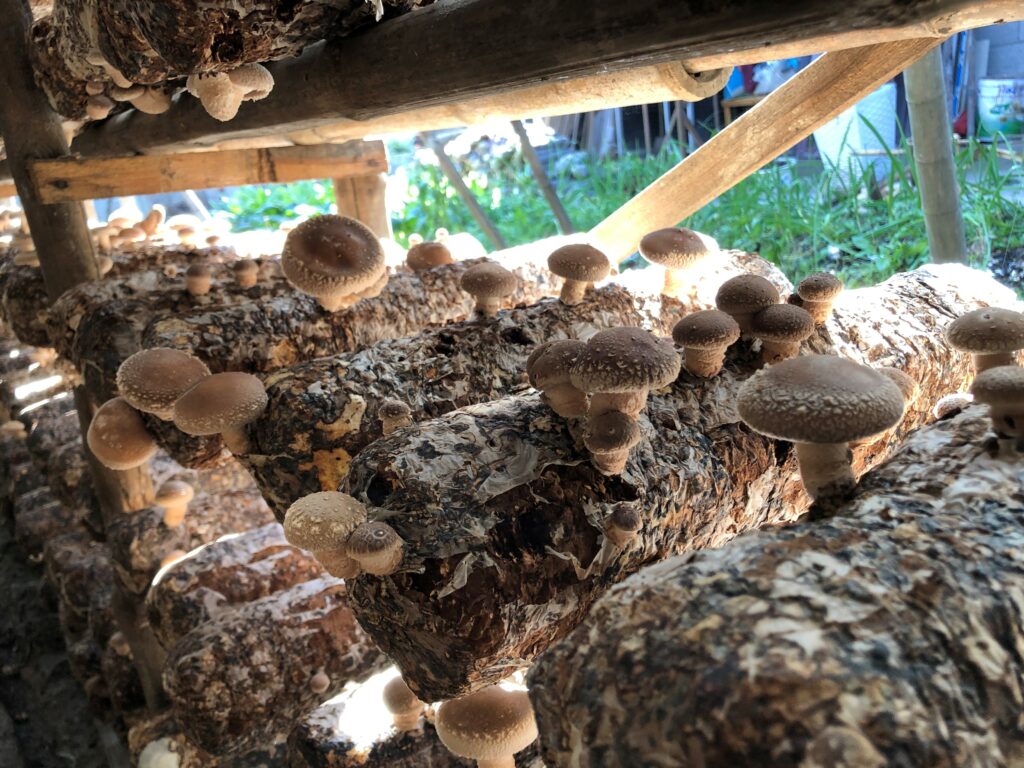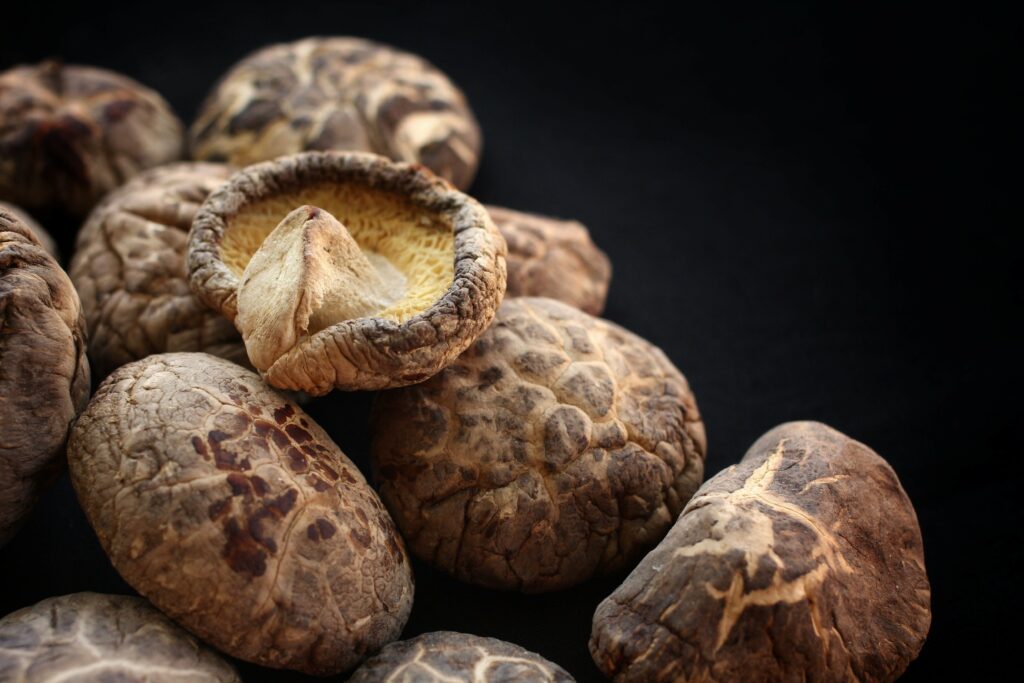Wild Shiitake mushrooms are mainly distributed in Anhui, Suzhou, Shanghai, etc., and cultivated Shiitake mushrooms are produced all over China .
Herbs in Life

- Growing Environment
- Characteristics
- History
- Composition
- Processing Practice
- Food safety
- References
The environment requirements for the growth of Shiitake mushrooms are similar to many other species of mushrooms. Water, light, nutrients, pH and temperature play indispensable roles in the growth and development of Shiitake mushrooms. Shiitake mushrooms have different requirements for water in their different growth stages, and the humidity of 55% to 65% is the most suitable environment for their growth. Temperature has a great influence on the quality, shape and color of Shiitake mushrooms. When the temperature of the environment is above 35 ℃, Shiitake mushrooms grow rapidly but are easy to age. They have strong tolerance to low temperature and can survive for 2 months at 5 ° C. In terms of pH, pH value of 3.5 to 4.5 is the most suitable range for the growth of Shiitake mushroom sporocarp[1] 劉春如. "香菇的分佈概況及生物學特性." 中國林副特產 4 (2001): 32-33.. China is the first country in the world to cultivate Shiitake mushrooms, with a history of 800 years. With the substantial increase in the demand for Shiitake mushrooms, the supply of wild Shiitake mushrooms fell short of the demand, and artificially cultivated Shiitake mushrooms began to appear, mainly with the method of basswood cultivation or bagged substrate cultivation.
Shiitake mushrooms are umbrella-like in shape. They are hemispheric when immature and slightly flat when mature. They are in dark brown or light brown colors. They often have dark scales in the middle, and white hairy or flocculent scales at the edge. Inside the Shiitake mushrooms, there is white flesh with fine texture and unique fragrance.

Figure 1: Shiitake mushrooms cultivated on bagged substrate.

Figure 2: Shiitake mushrooms after processing.
Shiitake mushrooms are rich in nutrition, and delicious in taste. Shiitake mushrooms are commonly used food, they are known as the “Queen of Plants” and “Anti-cancer Recruits”, and they occupy an important position among the edible fungi. In Qing Dynasty, it is recorded in a comprehensive medical book, “Yi Lin Cuan Yao”, that Shiitake mushrooms are “sweet and cold”, and “could remove bean poison”. According to the “Compendium of Materia Medica”, Shiitake mushrooms are ‘dry, flat and non-toxic’[2] 楊銘鐸, 龍志芳, and 李健. 香菇風味成分的研究. Diss. 2006.. With the improvement of living standards, Shiitake mushrooms are increasingly popular. They have become the third largest group of edible fungi in the world, and are widely consumed in China and neighboring Asian countries such as Japan, South Korea and North Korea.
Shiitake mushrooms are not only unique in fragrance, but also have health care functions. Their rich nutritional value is attributed to its rich lentinan, proteins, minerals, vitamins and other biological active substances. These active substances enable Shiitake mushrooms to have the functions of immune regulation, anti-tumor, regulating blood pressure and blood lipids, protecting the liver, regulating the spleen and stomach, and supplementing micro elements, etc.
1. Polysaccharides-Lentinan
Lentinan is a kind of polysaccharide extracted from the sporocarp of Shiitake mushrooms, and has a wide range of pharmacological effects. At present, large numbers of studies have shown that lentinan has an important immunomodulatory effect and can improve the body metabolism. Recent studies have shown that β-glucan extracted from edible Shiitake mushrooms has positive effects on the immunotherapy of COVID-19 through immunomodulatory and protective effects on lung cells [4] Murphy, Emma J., et al. "β-Glucan extracts from the same edible shiitake mushroom Lentinus edodes produce differential in-vitro immunomodulatory and pulmonary cytoprotective effects—Implications for coronavirus disease (COVID-19) immunotherapies." Science of the Total Environment 732 (2020): 139330.. Polysaccharides and their derivatives in Shiitake mushrooms have anti-tumor effects, but without any side effects, and are especially suitable for post-disease rehabilitation [5] Zhang, Mei, et al. "Antitumor polysaccharides from mushrooms: a review on their isolation process, structural characteristics and antitumor activity." Trends in Food Science & Technology 18.1 (2007): 4-19.. Lentinan also plays the role of lowering blood lipid and regulating blood pressure by promoting cholesterol metabolism [6] Kim, Se-Young, et al. "Cholesterol lowering action and antioxidant status improving efficacy of noodles made from unmarketable oak mushroom (Lentinus edodes) in high cholesterol fed rats." Journal of the Korean Society for Applied Biological Chemistry 52.3 (2009): 207-212.. Lentinan has obvious liver protection effect and can enhance the detoxification ability of the human body. Regular consumption of Shiitake mushrooms can improve the function of spleen and stomach [7] Sasidharan, Sreenivasan, et al. "In vitro antioxidant activity and hepatoprotective effects of Lentinula edodes against paracetamol-induced hepatotoxicity." Molecules 15.6 (2010): 4478-4489., and can improve the sub-health problems in modern life.
2. Proteins and trace minerals
Shiitake mushrooms are rich in protein, and among them, there are 18 kinds of amino acids which compose protein, including the 7 kinds of essential amino acids that are necessary for human body[8] Agostoni, Carlo Virginio, et al. "Scientific Opinion on the safety of “Lentinus edodes extract”(Lentinex®) as a Novel Food ingredient." (2010).. Every 100g of Shiitake mushroom contains 124mg of calcium, 415mg of phosphorus and 26mg of iron. Therefore, Shiitake mushrooms are a good source of calcium, iron and phosphorus in dietary therapy [9] Wasser, Solomon P. "Shiitake (Lentinus edodes)." Encyclopedia of dietary supplements (2005): 653-664.. Shiitake mushrooms also contain micro elements such as manganese, zinc, copper, magnesium and selenium, which can maintain normal metabolism of the body and prolong lifespan.
3. Vitamins
The vitamin content of dried Shiitake mushroom is much higher, among which vitamin D2 (calciferol) is about 1 μg/100g of dry weight. In addition, Shiitake mushrooms contain a large amount of B vitamins, and they also contain vitamin C at about 30 mg/100 g of dry weight[10] Mattila, Pirjo, et al. "Contents of vitamins, mineral elements, and some phenolic compounds in cultivated mushrooms." Journal of agricultural and food chemistry 49.5 (2001): 2343-2348..
The processing methods of Shiitake mushrooms are simple and economical, mainly including sun-drying method and oven drying method. When Shiitake mushrooms are about 70% to 80% ripe, they are harvested and spread out to dry on sunny days, and can be dried in about 3 to 5 days. The oven drying method needs to use an oven as a drying equipment for Shiitake mushrooms. Place the harvested Shiitake mushrooms in the oven, within 3 to 4 hours of harvest, and dry them until the water content of the Shiitake mushrooms is about 11% to 13%.
Shiitake mushrooms are widely recognized as a pollution-free, green and natural health product. The earliest record of Shiitake mushroom cultivation in Japan is also about 378 years ago. The nutritional composition and efficacy of Shiitake mushrooms were studied extensively and deeply for a long time, and no toxic side effects of Shiitake mushrooms have been found in the existing scientific studies[11] Yamaguchi, Yoshiyuki, Eiji Miyahara, and Jun Hihara. "Efficacy and safety of orally administered Lentinula edodes mycelia extract for patients undergoing cancer chemotherapy: a pilot study." The American journal of Chinese medicine 39.03 (2011): 451-459.. As a medical and health food material, Shiitake mushrooms have a very broad prospect. Based on the pre-clinical study of Shiitake mushrooms in rats conducted by the Laboratory of Toxicological Research at the University of Sorocaba in Brazil, the daily intake of 100mg/kg of Shiitake mushrooms was safe in vivo and had significant antioxidant effects[12] Grotto, Denise, et al. "Assessment of the safety of the shiitake culinary-medicinal mushroom, lentinus edodes (agaricomycetes), in rats: Biochemical, hematological, and antioxidative parameters." International journal of medicinal mushrooms 18.10 (2016).. In addition, the sporocarp powder or extract of Shiitake mushrooms has long been used as a commercial dietary supplement in Western countries[13] Gründemann, Carsten, et al. "Comparative chemical and biological investigations of β-glucan-containing products from shiitake mushrooms." Journal of functional foods 18 (2015): 692-702.. Shiitake mushrooms have been used as a daily dietary supplement to regulate human functions for a long time, which showed their effectiveness and safety.
